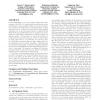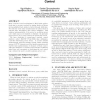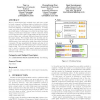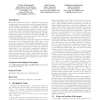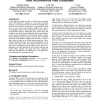WWW
2009
ACM
15 years 7 days ago
2009
ACM
Social Networking is one of the major technological phenomena of the Web 2.0, with hundreds of millions of people participating. Social networks enable a form of self expression f...
WWW
2009
ACM
15 years 7 days ago
2009
ACM
In this paper, we study a novel problem of staring people discovery from social networks, which is concerned with finding people who are not only authoritative but also sociable i...
WWW
2009
ACM
15 years 7 days ago
2009
ACM
Many overload control mechanisms for Web based applications aim to prevent overload by setting limits on factors such as admitted load, number of server threads, buffer size. For ...
WWW
2009
ACM
15 years 7 days ago
2009
ACM
With the proliferation of data APIs, it is not uncommon that users who have no clear ideas about data APIs will encounter difficulties to build Mashups to satisfy their requiremen...
WWW
2009
ACM
15 years 7 days ago
2009
ACM
Web 2.0 technologies have enabled more and more people to freely comment on different kinds of entities (e.g. sellers, products, services). The large scale of information poses th...
WWW
2009
ACM
15 years 7 days ago
2009
ACM
For the last few years we have studied the diffusion of private information about users as they visit various Web sites triggering data gathering aggregation by third parties. Thi...
WWW
2009
ACM
15 years 7 days ago
2009
ACM
The ImpressionRank of a web page (or, more generally, of a web site) is the number of times users viewed the page while browsing search results. ImpressionRank captures the visibi...
WWW
2009
ACM
15 years 7 days ago
2009
ACM
WWW
2009
ACM
15 years 7 days ago
2009
ACM
To deal with the problem of empty or too little answers returned from a Web database in response to a user query, this paper proposes a novel approach to provide relevant and rank...
WWW
2009
ACM
15 years 7 days ago
2009
ACM
We present the results of a community detection analysis of the Wikipedia graph. Distinct communities in Wikipedia contain semantically closely related articles. The central topic...
